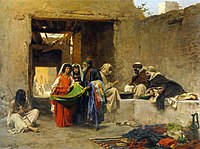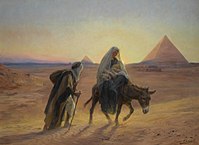Eugène Girardet
Eugène Alexis Girardet (born May 31, 1853 in Paris ; † May 5, 1907 there ) was a French painter and etcher of Orientalism .
Eugène Girardet came from a Swiss Huguenot family and was the son of the engraver Paul Girardet and brother of the artists Julia Antonine Girardet , Jules Girardet , Léon Girardet , Paul Armand Girardet and Théodore Girardet .
Girardet learned the art of copperplate engraving from his father. He studied at the École des Beaux-Arts in Paris in the studio of Jean-Léon Gérôme . Gérôme encouraged him to visit North Africa in 1874, including Morocco and Tunisia, as well as Spain .
From 1879 he made eight trips to Algeria , mainly visiting the south of the country around the oases of Biskra , Bou Saâda and El Kantara, where he met the oriental painter Étienne Dinet . In 1898 he went to Egypt and Palestine . He depicted genre scenes from nomadic life or desert landscapes. Unlike other oriental painters, he did not create harem scenes. He taught at the Académie Julian in Paris .
He exhibited at the Salon of the National Society of Fine Arts, the Salon of the Society of French Oriental Painters, the Paris Salon , the Paris World Exhibition in 1900 , where he won a gold medal, and the Colonial Exhibition of Marseille in 1906. He also showed his works at the Great Berlin Art Exhibition (1891, 1896, 1899, 1901) and in the Munich Glass Palace (1888, 1897).
Eugène Girardet died in Paris in 1907 and was buried in the Père-Lachaise cemetery.
His works can be found in the Musée d'Orsay in Paris and in the museums in Dijon , Nantes , Troyes as well as in Zurich , Geneva , New York and Algiers .
literature
- Marie Tripet: Girardet, Eugène-Alexis . In: Carl Brun (Ed.): Swiss Artist Lexicon . Volume 1: A-G. Huber & Co., Frauenfeld 1905, p. 582 ( Textarchiv - Internet Archive ).
- Girardet, Eugène . In: Ulrich Thieme , Fred. C. Willis (Ed.): General lexicon of visual artists from antiquity to the present . Founded by Ulrich Thieme and Felix Becker . tape 14 : Giddens-Gress . EA Seemann, Leipzig 1921, p. 165 ( Textarchiv - Internet Archive ).
- René Burnand: L'Étonnante Histoire des Girardet: artistes suisses . La Baconnière, Neuchâtel 1940, p. 299.
- Lynne Thornton: Les Orientalistes, Peintres voyageurs 1828–1908 . ACR édition, Courbevoie (Paris) 1983, pp. 108-109.
- Renate Treydel: Girardet, Eugène . In: General Artist Lexicon . The visual artists of all times and peoples (AKL). Volume 55, Saur, Munich a. a. 2007, ISBN 978-3-598-22795-0 , p. 185.
Web links
- Girardet, Eugène Alexis. Biographical data and works in the Netherlands Institute for Art History (Dutch)
- Girardet, Eugène-Alexis. In: Sikart
- Lucie Girardin-Cestone: Girardet, Eugène. In: Historical Lexicon of Switzerland .
| personal data | |
|---|---|
| SURNAME | Girardet, Eugène |
| ALTERNATIVE NAMES | Girardet, Eugène Alexis (full name) |
| BRIEF DESCRIPTION | French painter |
| DATE OF BIRTH | May 31, 1853 |
| PLACE OF BIRTH | Paris |
| DATE OF DEATH | May 5, 1907 |
| Place of death | Paris |




